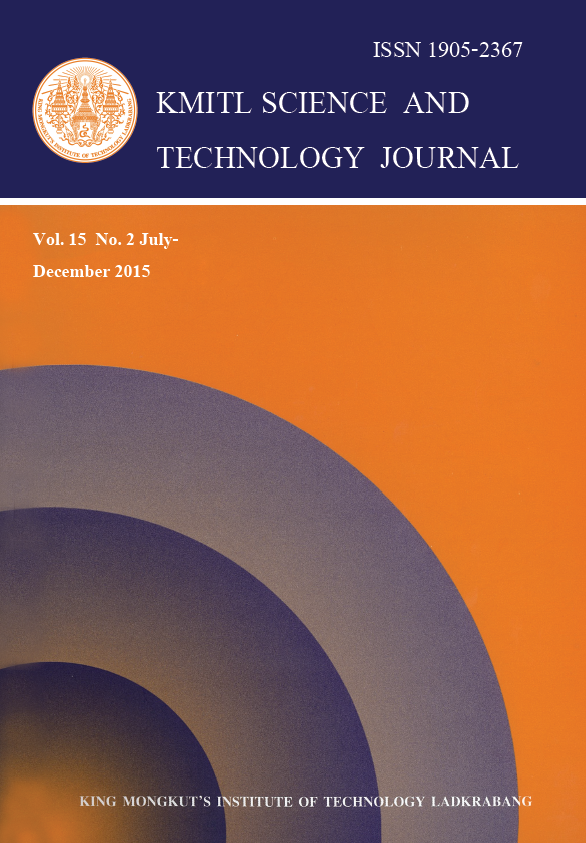Antimicrobial Activity of Acidophilic Actinomycetes Isolated from Acidic Soil
Main Article Content
Abstract
Acidophilic actinomycetes were isolated from acidic soil samples on Starch Casein Agar, Soil Extract Agar and Humic Vitamin Agar, pH 4.5, containing nystatin and nalidixic acid. The total acidophilic actinomycete counts ranged from 3.9-8.2 x 103 CFU/g of soil sample. Antibacterial activities of isolated actinomycetes were primarily screened by agar plug method. Three isolates exhibited antibacterial activity against all 4 tested bacteria, which were Bacillus cereus, Pseudomonas aeruginosa, Escherichia coli and Staphylococcus aureus. Furthermore, 10 isolates showed antifungal activity against Fusarium sp., Curvularia sp. and Colletotrichum gloeosporioides. The 14-day YM culture broth and mycelium of isolate AA01 and AA02 were extracted with hexane, ethyl acetate and methanol. The crude extracts of AA01 and AA02 were then tested for antibacterial and antifungal activity, respectively. The MIC values of methanolic crude extract from AA01 against B. cereus, P. aeruginosa, E. coli and S. aureus were 5, 20, 40 and 5 mg/ml, respectively. The methanolic crude extract from AA02 at concentration of 30 mg/ml can inhibit at least 50% of the fungal growth.
Keywords: acidophilic actinomycete, antibacterial activity, antifungal activity, acidic soil.
*Corresponding author: nchaisit@yahoo.com
Article Details
Copyright Transfer Statement
The copyright of this article is transferred to Current Applied Science and Technology journal with effect if and when the article is accepted for publication. The copyright transfer covers the exclusive right to reproduce and distribute the article, including reprints, translations, photographic reproductions, electronic form (offline, online) or any other reproductions of similar nature.
The author warrants that this contribution is original and that he/she has full power to make this grant. The author signs for and accepts responsibility for releasing this material on behalf of any and all co-authors.
Here is the link for download: Copyright transfer form.pdf
References
[2] Olano, C., Mendez, C. and Salas, J.A., 2009. Antitumor Compounds from Marine Actinomycetes. Marine Drugs, 7, 210-248.
[3] Vimal, V., Rajan, B.M. and Kannabiran, K., 2009. Antimicrobial activity of marine actinomycete, Nocardiopsis sp. VITSVK 5 (FJ973467). Asian Journal of Medical Sciences, 1(2), 57-63.
[4] Seong, C.N., Park, S.K., Goodfellow, M., Kim, S.B. and Hah, Y.C., 1995. Construction of probability identification matrix and selective medium for acidophilic actinomycetes using numerical classification data. Journal of Microbiology, 33, 95-102.
[5] Kim, S.B., Lonsdale, J., Seong, C.N. and Goodfellow, M., 2003. Streptacidiphilus gen. nov., acidophilic actinomycetes with wall chemotype I and emendation of the family Streptomycetaceae (Waksman & Henrici 1943AL) emend. Rainey et al. 1997. Antonie Van Leeuwenhoek, 83, 107-116.
[6] Williams, S.T. and Khan, M.R., 1974. Antibiotics - a soil microbiologist’s viewpoint. Postepy Hig Med Dosw, 28, 395-408.
[7] Williams, S.T. and Robinson, C.S., 1981. The role of streptomycetes in decomposition of chitin in acidic soils. Journal of General Microbiology, 127, 55-63.
[8] Thawai, C., Tanasupawat, S. and Kudo, T., 2008. Micromonospora pattaloongensis sp. nov., isolated from a Thai mangrove forest. International Journal of Systematic and Evolutionary Microbiology, 58, 1516-1521
[9] Thawai, C., Tanasupawat, S., Pongpech, P. and Suwanborirux, K., 2000. Antibiotic-Producing Actinomycetes from Peat Swamp Forest Soils in Trang. The Thai Journal of Pharmaceutical Sciences, 24, 40.
[10] Mohanraj, D., Bharathi, S., Radhakrishnan M. and Balagurunathan, R., 2011. Bioprospecting of actinobacteria from Yelagiri hills with special reference to antibacterial activity. Journal of Chemical and Pharmaceutical Research, 3(3), 439-446.
[11] Clinical and Laboratory Standards Institute (CLSI)., 2003. Methods for Dilution Antimicrobial Susceptibility Tests for Bacteria That Grow Aerobically: Approved Standard. M7-A6, CLSI, Pennsylvania, Pa, USA, 6th edition.
[12] Williams, S.T., Davies, F. L., Mayfield, C. I. and Khan, M. R., 1971. Studies on the ecology of actinomycetes in soil. II. The pH requirements of streptomycetes from two acid soils. Soil Biology & Biochemistry, 3, 187-195.
[13] Lonsdale, J.T., 1985. Aspects of the biology of acidophilic actinomycetes. PhD thesis, University of Newcastle, UK.
[14] Huang, Y., Cui, Q., Wang, L., Rodriguez, C., Quintana, E.,Goodfellow, M. and Liu, Z., 2004. Streptacidiphilus jiangxiensis sp. nov., a novel actinomycete isolated from acidic rhizosphere soil in China. Antonie van Leeuwenhoek, 86, 159-165.
[15] Kim, S. B., Seong, C. N., Jeon, S. J., Bae, K. S. and Goodfellow, M., 2004. Taxonomic study on neutrotolerant acidophilic actinomycetes isolated from soil and description of Streptomyces yeochonensis sp. nov. International Journal of Systematic and Evolutionary Microbiology, 54, 211-214.
[16] Silambarasan, S., Praveen kumar, E., Murugan, T., Saravanan, D. and Balagurunathan, R., 2012. Antibacterial and antifungal activities of Actinobacteria isolated from Rathnagiri hills. Journal of Applied Pharmaceutical Science, 2(10), 99-103.
[17] Bansal, S., Malwal, M. and Sarin, R. 2010. Anti-bacterial efficacy of some plants use in folkaric medicines in arid zone. Journal of Pharmacy Research, 3, 2640-2642.
[18] Zakalyukina, Y.V. and Zenova, G.M., 2007. Antagonistic activity of soil acidophilic actinomycetes. Biology Bulletin, 34(4), 329-32.
[19] Khan, M.R. and Williams, S.T., 1975. Studies on the Ecology of Actinomycetes in Soil: Distribution and Characterictics of Acidophilic Actinomycetes. Soil Biolology & Biochemistry, 7, 345-349.
[20] Flower, T.H. and Williams, S.T., 1977. The Influence of pH on the growth rate and viability of neutrophilic and acidophilic Streptomyces. Microbiology, 18, 48-54.


